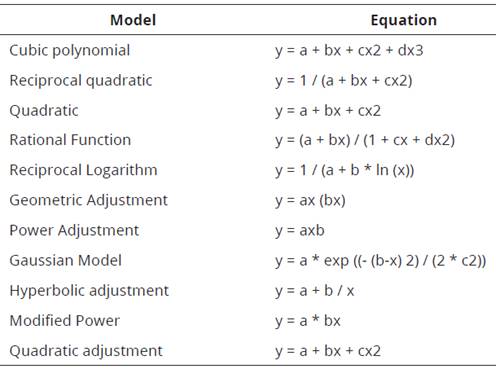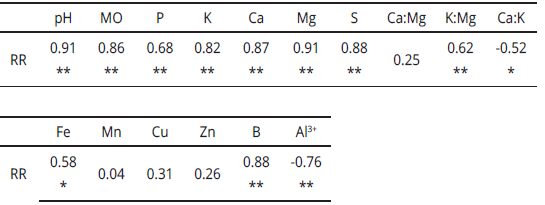Introduction
Ecuador is currently the major exporter of peach palm (Bactris gasipaes Kunth.), also known as pejibaye, covering about 62% of global demand. It is cultivated mainly in tropical zones where present climatic and agroecological conditions of soils, according to PRO ECUADOR (2015), ideal for their production.
This crop presents potential for agricultural diversification in the northwestern areas of Pichincha and Santo Domingo de los Tsáchilas, owing to their rusticity and adaptability to the edaphoclimatic characteristics of these areas. In Ecuador, it is cultivated mainly by small producers who perform conventional soil management and crop nutrition, without reference information or an interpretation guide, detailing the critical levels of nutrients in the soil and foliage, which finally affects the quality of the product.
The reference levels used for the management of nutrition, are results of research carried out in plantations in Costa Rica, which, for Molina (1999), are still scarce and inconclusive. Therefore, studies in Ecuador, one of the largest producers of palm in the world, would significantly improve the understanding of the soil fertility conditions needed to obtain high yields.
The determination of soil nutrient critical levels and tissues, is important in estimating soil bioavailability, plant nutritional status, and would be useful as a soil and leaf interpretation guide, fertilizers and amendments suggestions, according to the growing area.
Many authors, use the absolute values of soil analysis to determine their fertility. However, it is also important to know the nutrient balance throughout soil cation exchange capacity (Combatt et al., 2012). In Brazil, soil cation exchange capacity is used to represent the availability of the elements, but without experimental results (Raij, 2011). According to Malavolta et al. (1997), the Mg2+ deficiency may occur, by high concentrations of Ca2+ and especially K+ in soil solution, by competitive inhibition of root uptake. In addition, NH4+ and Mn2+ (Dechen & Nachtigall, 2007) and by the displacement of Mg2+ from the exchange complex and leaching loss (Tisdale et al., 1993). The optimum ratio of Ca: Mg to maize fluctuates between 3: 1 and 5: 1 (Coelho, 2008). In plantain, the optimum soil cation exchange capacity is Ca: Mg = 22.1, Ca: K = 20.3, Mg: K = 15.8 and (Ca + Mg): K = 36.1 (Combatt et al., 2012).
Analyze the area of Santo Domingo de los Tsáchilas, to define the critical levels of nutrients in the soil was the aim of this work, as well as evaluate the relations between the values of soil cationic nutrients available and improve nutrition performance.
Materials and methods
The research was conducted in the second half of 2014 in the area of Santo Domingo de los Tsáchilas (road to Quevedo, Quinindé, Chone and Las Mercedes), Ecuador, within a 35 km radius of the INAMHI meteorological station, which is geographically located at 79´12´´Longitude West and 0´14´´ south latitude at 425 m. a. s. l., with rainfall of 3338 mm.year-1. Mean annual temperature of 24°C, relative humidity of 88% and heliophania of 761.2 light hours per year (National Institute of Meteorology and Hydrology, 2014). Soils originate from undifferentiated sedimentary volcanic rocks (Schobbenhaus & Bellizia, 2001), amorphous minerals, with indirect evidence of allophane as predominant clay, free texture with <35% clay, acid pH (less than 5.5) with 10 to 60 % of CIC saturated in aluminum, up to 50 cm and classified as Andepts (Mejía, 1997).
The factor in this research, was the commercial cultivation of B. gasipaes, using a total of 20 farms, where composed soil samples (20 subsamples) were collected in zig-zag at a depth of 20 cm during the months of September and October.
Variable in study
Soil chemical characteristics were determined: pH with soil: water ratio of 1: 2.5., organic matter with the Walkley-Black method (Silva et al., 2009), ammoniac N, P, K, Ca, Mg, Fe, Cu, Mn and Zn with modified Olsen method, B and S, with monocalcium phosphate and Al+3 exchangeable with KCl (Rojas et al., 1989). The N, P and B readings were performed by colorimetry, S by turbidimetry (Cole Parmer 1100 Spectrophotometer photocolorimeters) and the cations by atomic absorption (Shimadzu AA-6800).
Determination of soil critical levels
Using the pH, MO, N, P, K, Ca, Mg, S, Fe, Mn, Cu, Zn and B soils analysis results, were completed regressions with yield relative performance, applying no lineals models regressions (Table 1). The relative performance was obtained accordingly to Wendling et al. (2008), with the relation:
RP = ("a" x100) / MET, where:
RP, Relative performance, "a", Estimated crop yield and MET, maximum technical efficiency (maximum yield recorded in this research).
Each element was selected applying the best model with the greatest fit data (highest determination coefficient R), and the critical level was established, considering as Wendling et al. (2008), to the amount of nutrient available in the soil, corresponding to 90% of maximum yield, definition adopted in the fertilization programs in Rio Grande do Sul, Santa Catarina, Brazil. The Curve Expert program (versión 1.3. (tm)) was adopted to adjust the data.
Determination of the ideal Ca: Mg: K soil cation exchange capacity for B. gasipaes
The cationic relations between Ca, Mg and K, were established from the results of critical soil levels (cmol.dm-3), employing the relations applied by Bosch et al. (1995), and adjusted for soil values in cmol.dm-3, the relation for K+ was determined as follows:
Ratio K = 100 * (K / (Ca + Mg + K))
Where:
K = Critical level of K in soil (cmol.dm-3)
Ca = Critical level of Ca in soil (cmol.dm-3)
Mg = Critical level of Mg in soil (cmol.dm-3)
Results and discussion
Determination of critical soil levels
The effect of soil pH on B. gasipaes performance was adequately described by the cubic polynomial model (r = 0.92), observing an increase in yield as soil pH rises (Figure 1a), and its critical level of 6.3. This is related to the decrease in the Al+3 availability, element which toxicity can reduce the P availability, forming phosphates of low solubility (Sousa, Miranda & Oliveira, 2007), generally affecting the radical development of microorganisms, decreasing the soil volume explored and the possibility of water and nutrients absorption (Molina, 2001; Eckhard, Horst & Neuman, 2011).
The soil organic matter, whose composition varies by its formation of several types of vegetal residues and helps to supplies important amounts of N to the system in the form of NH+4, NO-3 and NO-2, which is a small part of the total N soil (Raij, 2011), had a positive influence on B. gasipaes yield until approximately 8.0%, with a critical value of 6.3% (Figure 1b).
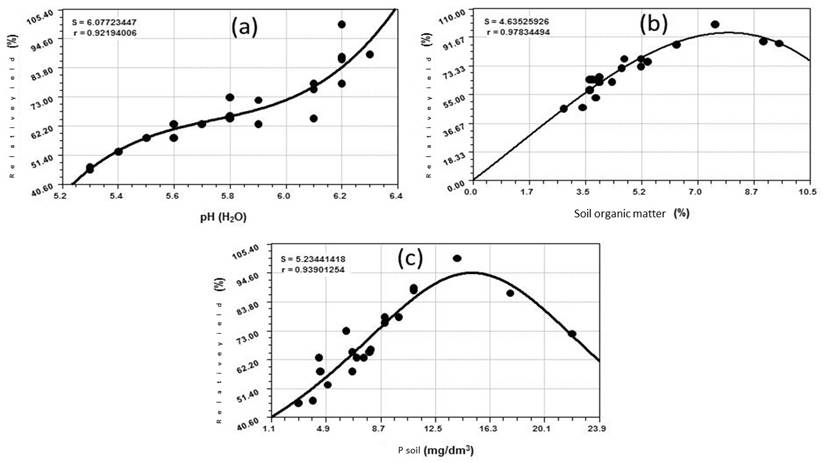
Figure 1 Relation between the relative yield and the values of pH (a), organic matter (b) and phosphorus (P) (c) in Santo Domingo de los Tsáchilas, Ecuador andisols cultivated with peach palm
The effect of P on the relative crop yield was adequately explained by the quadratic reciprocal model (r = 0.93). It was determined 12.26 mg.dm-3 as critical P level (Figure 1c), similar to the 10 mg.dm-3 reported by Ares et al. (2002), for ultisols of Costa Rica.
The balanced application of nutrients is an important activity which have allowed to establish a high fertility in the volcanic soils dedicated to oil palm cropped in Ecuador (Mite et al., 1999) and also for peach palm. The critical level of K+ found using the squared fit model (r = 0.89), in the present study was 0.67 cmolc.dm-3 (Figure 2a). These results are similar to Molina (1999), which analysis indicate the optimal K value in Costa Rica, was higher than 0.3 cmolc.dm-3, obtaining plants with characteristics suitable for peach palm production.
Using 90% of the relative yield and using the rational function statistical model (r = 0.96), the critical level found was 5.1 cmol.dm-3 of Ca in soil (Figure 2b), which is high (> 0.7 cmol.dm-3 Ca), as indicated by Raij (2011).
Mg positively affects the relative crops yield, acting on the activation of enzymes which influence respiration, photosynthesis and regulation of cellular pH and cation: anion balance (Hawkesford et al., 2012), often presenting visual symptoms of deficiency, suggesting a high requirement of this element. In this research, the effect of Mg on performance is adequately described by the rational function model with r = 0.97, finding 0.97 cmol. dm-3 as critical level (Figure 2c), value close to 0.80 cmol.dm-3, indicated by Raij (2011 ), as the limit between high and medium levels for soils.
The rational function model was adjusted positively, with r = 0.97, to the relation between the relative yield and the S content in the soil, reaching the critical level of 7.54 mg.dm-3 (Figure 2d), below the level of 10 mg.dm-3 reported by Molina (1999), in soils of Costa Rica.
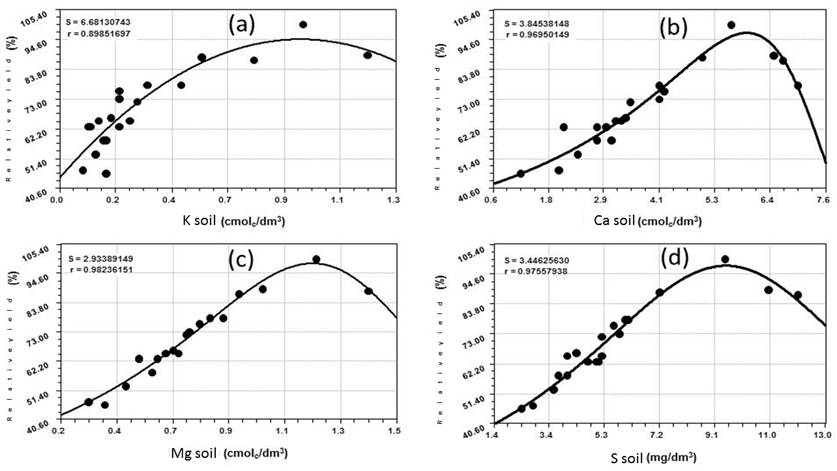
Figure 2 Relation between relative yield and potassium (K) (a), calcium (Ca+2) (b), magnesium (Mg+2) (c) and sulfur (S+2) (d) values in andisols of Santo Domingo de los Tsáchilas, Ecuador cultivated with peach palm
Among the minor elements, except Mn, Cu and Zn, the critical levels found in this work, were adjusted positively and significantly with the relative crop yield, as well as for Fe 161 mg.dm-3 (Figure 3a) and B 0.51 mg.dm-3 (Figure 3b), there was no significant adjustment for Mn+2, Cu+2 and Zn+2 (critical levels of 10.6 mg.dm-3, 6.3 mg.dm-3, 4.4 mg.dm-3, respectively), elements whose availability depends on soil pH. These values were similar to those reported by Molina (1999), for Fe+2, B+2, Mn+2, Cu+2 and Zn+2 when determining the optimal soil chemical characteristics for peach palm cultivation in Costa Rica.

Figure 3 Relative yield and iron (Fe+2) (a) and boron (B+2) (b) contents relation in andisols of Santo Domingo de los Tsáchilas, Ecuador, cultivated with peach palm
The critical level of Al+3 was determined adequately with the geometric fit model (r = 0.53) and resulted from 1.0 cmol.dm-3 (Figure 4a), showing average variability of relative performance. This agrees with the reports of Molina (1999), for soils of Costa Rica, showing as optimal value of Aluminum <1.0 cmol.dm-3, while the critical level of Al saturation was 20% (Figure 4b).
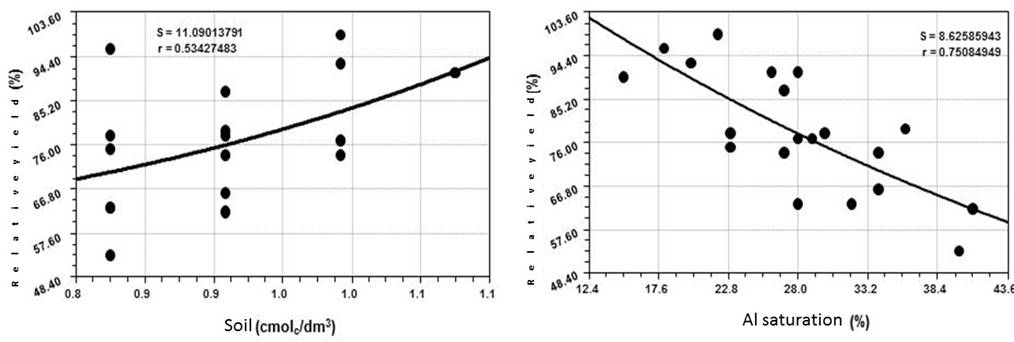
Figure 4 Relation between relative yield and aluminum (Al) available (a) and aluminum saturation (b) in Andisols of Santo Domingo de los Tsáchilas, Ecuador, cultivated with peach palm
The nonlinear regression models who approach to this data set to determine the critical level of each element in the soil are detailed in Table 2, whose objective was to divide the sample population into a high response group (Considered the points below the critical level) and a low response group (estimated above the critical level), maximizing the coefficient of determination by successive approximations of critical levels. The proper adjustment of the different regression models can be visualized in Table 2, with determination coefficients greater than 0.89 (P <0.001) between pH, MO and nutrient contents P, Ca, Mg, K, S and B in soil and relative yield of peach palm cultivation. Whereas, there was no good adjustment of microelements Mn+2, Cu+2 and Zn+2.
The effect of the bases on the relative yield is adequately described by the models used, according to the regressions presented in Table 3, presenting coefficients of determination greater than 0.89, with P <0.001.
Based on the critical levels of the bases in the soils evaluated in this research and related to 90% of the relative yield, a Ca: Mg: K ratio of 76:14:10 was obtained (Table 4), considered ideal for peach palm crop in andisols of Santo Domingo of the Tsáchilas, Ecuador. This relations differs from one who was reported using the same formula by Bosch et al. (1995), of 75: 19: 6 (Ca: Mg: K) and with data from Molina (1999), for peach palm cultivation in Costa Rica.
Table 2 Equations and correlation coefficients between pH, OM and soil nutrient contents, relative yield (%)
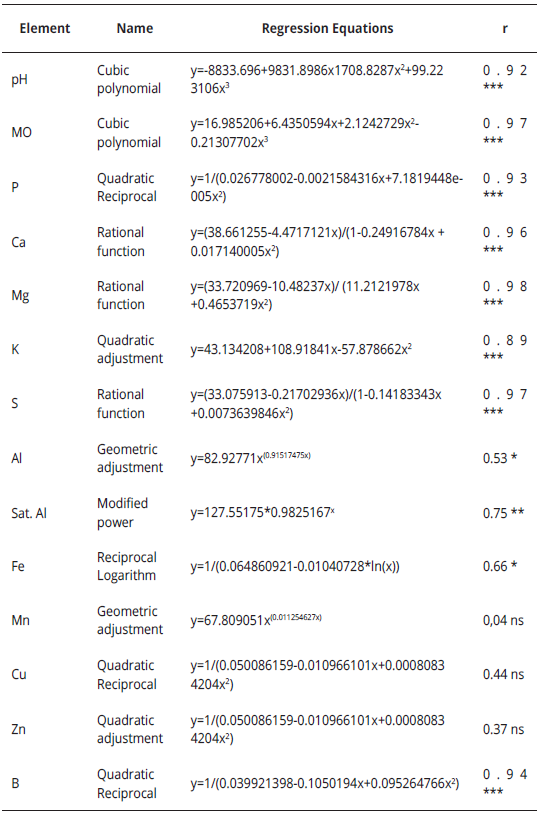
*, ** Y*** significant determination coefficients for P≤0.05, P≤0.01 and P≤0.001 respectively; Ns = Not significant.
Table 3 Coefficients of determination between the soil bases Ca+2, Mg+2, K and 90% of the potential relative yield

***Very highly significant coefficients of determination for P≤0.001.
Table 4 Cationic ratio Ca: Mg: K ideal in soil, for B. gasipaes cultivation in andisoles of Santo Domingo de los Tsáchilas, Ecuador

§ = Calculations for a potential relative yield of 90%.
The ideal relation of Ca: Mg ratio was 5.22, substantially higher than the 4.0 obtained with the data reported by Molina (1999). The relations (K + Mg): K was 9.0, which was low when compared to those of Molina (1999), indicating that in soils of Santo Domingo de los Tsáchilas, Ecuador the contents of K are greater than those of Costa Rica.
Considering the critical values of the bases used for the determination of the ideal soil cation exchange capacity of Ca: Mg: K, a base sum of 6.74 cmol. dm-3, established in the culture of peach palm, which coincides with Molina (1999), data quite important to maintain values of summation of bases > 5 cmol.dm-3, to obtain high yields.
Based on the resulting optimal values, the ideal ratio of 1.45 for Mg: K was found to be lower than the ratio of 3.3 exposed by Molina (1999), due to the high content of K in relation to the Mg+2 of these soils.
The ideal Ca: Mg ratio was 5.22, which was higher than the 4.0 obtained with the data reported by Molina (1999). The relation (K + Mg): K was 9.0, which was low when compared to those of Molina (1999), indicating that in the soils of Santo Domingo de los Tsáchilas, Ecuador, the contents of K are greater than those of Costa Rica.
In general, in the evaluated soils of Santo Domingo de los Tsáchilas, Ecuador, the contents of Ca+2 changed from low to high levels. For Mg+2, the vast majority are low. While K levels are elevated, directly affecting the relations, and may be a consequence of the fertilizer practices performed by the producers, where N and K applications are prioritized with respect to Ca and Mg, resulting in variations with the levels found by Molina (1999), in Costa Rica.
Correlations
The relative yields of the peach palm, had a highly significant positive correlation with r values higher than 0.6 for pH, OM, macronutrients, and with Fe+2 and B+2 of the micronutrients (Table 5), indicating the direct relation between higher soil quantity with higher yields. On the contrary, significant negative correlations of -0.52 and -0.76 were observed with the Ca: K ratio and Al saturation percentage, demonstrating the implications of the higher values of these variables with the lower yields.
Conclusion
The optimal soil critical levels to reach 90% of the potential relative yield were: 6.3 pH; 6.5% MO; 12.3 mg.dm-3 P; 0.67 cmolc.dm-3 K; 5.1 cmolc.dm-3 Ca; 0.97 cmol.dm-3 Mg; 7.5 mg.dm-3 S; 161 mg.dm-3 Fe; 10.6 mg.dm-3 Mn; 6.3 mg.dm-3 Cu; 4.4 mg.dm-3 Zn and 0.51 mg.dm-3 B; Al saturation of 1.0 cmol.dm-3 and Al Saturation of 20%.
The cationic ratio Ca: Mg: K (cmol.dm-3) ideal for peach palm cultivation, growing in Santo Domingo de los Tsáchilas, Ecuador, andisols, was 76:14:10.
The yield of peach palm cultivated in Santo Domingo de los Tsáchilas, Ecuador, presents a high degree of dependence on variables such as soil pH, Mg+2, S+2, B+2, Ca+2 and SOM (soil organic matter).













